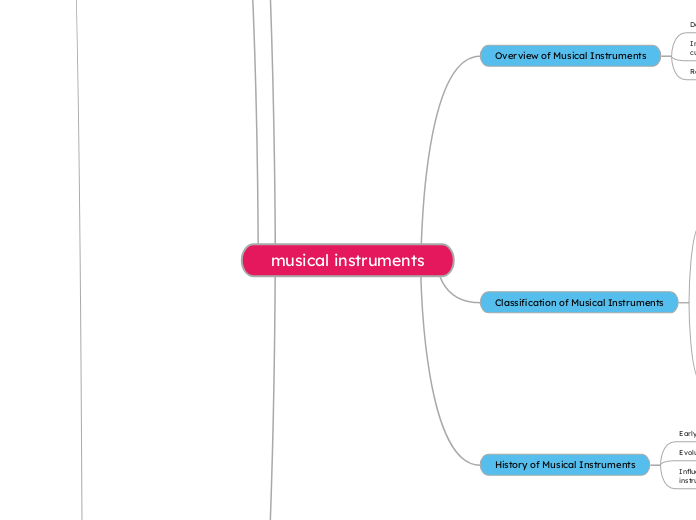musical instruments
Overview of Musical Instruments
Definition of musical instruments
Importance of musical instruments in various cultures
Role of musical instruments in creating music
Classification of Musical Instruments
Classification based on sound production
Percussion instruments
Drums
Cymbals
Tambourine
String instruments
Guitar
Violin
Piano
Wind instruments
Flute
Trumpet
Saxophone
Electronic instruments
Synthesizer
Electric guitar
Keyboard
Classification based on cultural origins
Western instruments
Eastern instruments
African instruments
Indigenous instruments
History of Musical Instruments
Early origins of musical instruments
Evolution of musical instruments over time
Influence of different civilizations on musical instrument development
Popular Musical Instruments
Piano
History and development of the piano
Different types of pianos
Famous pianists and compositions
Guitar
History and evolution of the guitar
Types of guitars
Notable guitar players and genres
Violin
Origins and development of the violin
Parts and components of a violin
Renowned violinists and compositions
Importance of Learning and Playing Musical Instruments
Cognitive benefits of learning musical instruments
Emotional and psychological benefits
Social benefits and opportunities for collaboration and expression
Detailed breakdown
Overview of Musical Instruments
Definition of musical instruments
Musical instruments are devices or tools used to create or produce sound
Importance of musical instruments in various cultures
Musical instruments are integral to cultural traditions and rituals
They help preserve cultural heritage and identity
Role of musical instruments in creating music
Musical instruments provide the means to express and convey emotions through sound
They contribute to the overall composition and arrangement of music
Classification of Musical Instruments
Classification based on sound production
Percussion instruments
Drums
Various types of drums
such as bass drums
snare drums
and bongo drums
Used to create rhythmic patterns and beats
Cymbals
Metallic instruments that produce a crashing or shimmering sound
Commonly used in orchestras and rock bands
Tambourine
Hand-held instrument with jingling metal discs or bells
Often used to add rhythm and texture to music
String instruments
Guitar
Versatile instrument with six strings that can be strummed or plucked
Used in various genres such as rock
classical
and jazz
Violin
Four-stringed instrument played with a bow
Prominent in classical music and orchestras
Piano
Keyboard instrument with strings that are struck by hammers
Widely used in classical and contemporary music
Wind instruments
Flute
Woodwind instrument played by blowing across a hole
Used in classical
jazz
and folk music
Trumpet
Brass instrument with a distinctive sound
Commonly used in jazz and classical music
Saxophone
Single-reed woodwind instrument
Popular in jazz
blues
and rock music
Electronic instruments
Synthesizer
Electronic instrument that generates various sounds
Used in electronic music
pop
and film scoring
Electric guitar
Guitar with electronic pickups that amplify the sound
Essential in rock
blues
and metal genres
Keyboard
Electronic instrument with keys that produce different sounds
Commonly used in pop
rock
and electronic music
Classification based on cultural origins
Western instruments
Instruments commonly associated with Western classical music
Examples include the piano
violin
and flute
Eastern instruments
Instruments traditionally used in Eastern music traditions
such as the sitar and erhu
African instruments
Instruments originating from Africa
such as the djembe and kalimba
Known for their unique rhythms and percussive sounds
Indigenous instruments
Instruments used by indigenous cultures around the world
Reflect the cultural and spiritual practices of these communities
History of Musical Instruments
Early origins of musical instruments
Evidence of musical instruments dating back to prehistoric times
Early instruments included flutes made from bone and drums made from animal skins
Evolution of musical instruments over time
Advancements in technology and craftsmanship led to the development of more complex instruments
Introduction of new materials and construction techniques
Influence of different civilizations on musical instrument development
Ancient civilizations like the Egyptians
Greeks
and Romans made significant contributions to instrument design and construction
Cultural exchange and trade routes facilitated the spread of musical instrument knowledge
Popular Musical Instruments
Piano
History and development of the piano
Evolution from earlier keyboard instruments like the harpsichord and clavichord
Invention of the modern piano by Bartolomeo Cristofori in the 18th century
Different types of pianos
Grand piano
upright piano
digital piano
Variation in size
sound quality
and portability
Famous pianists and compositions
Renowned pianists like Ludwig van Beethoven and Wolfgang Amadeus Mozart
Iconic piano compositions such as Beethoven's "Moonlight Sonata" and Mozart's "Piano Concerto No
21"
Guitar
History and evolution of the guitar
Origins in ancient civilizations
such as the lute in Mesopotamia and the oud in Persia
Development of the modern guitar in Spain during the 16th century
Types of guitars
Acoustic guitar
electric guitar
classical guitar
Distinctions in sound production and playing style
Notable guitar players and genres
Influential guitarists like Jimi Hendrix and Eric Clapton
Different genres associated with the guitar
such as rock
blues
and flamenco
Violin
Origins and development of the violin
Ancestor of the violin can be traced back to ancient stringed instruments like the rebec and Byzantine lyra
Modern violin design emerged in Italy during the 16th century
Parts and components of a violin
Body
neck
fingerboard
strings
bow
Importance of craftsmanship and materials in producing quality sound
Renowned violinists and compositions
Virtuosos like Itzhak Perlman and Niccolò Paganini
Iconic violin compositions such as Bach's "Sonatas and Partitas" and Vivaldi's "The Four Seasons"
Importance of Learning and Playing Musical Instruments
Cognitive benefits of learning musical instruments
Enhances memory
concentration
and problem-solving skills
Stimulates brain development and improves coordination
Emotional and psychological benefits
Provides a means of self-expression and emotional release
Boosts confidence
reduces stress
and promotes relaxation
Social benefits and opportunities for collaboration and expression
Allows for social interaction and participation in group settings
Provides a platform for artistic expression and cultural exchange
